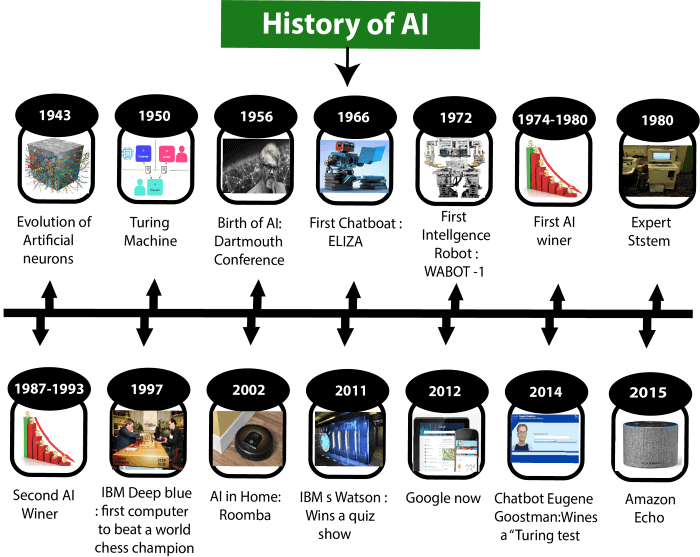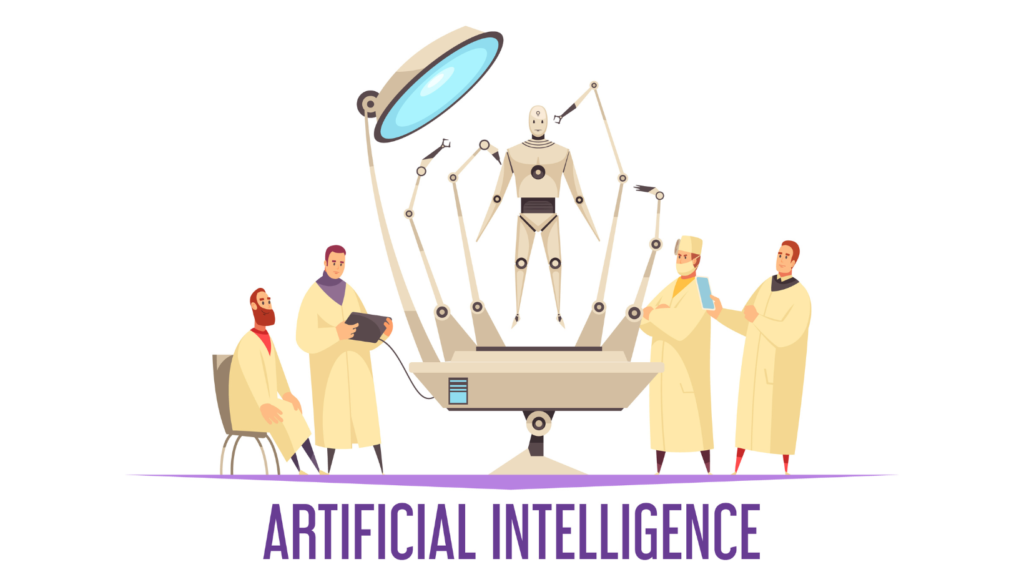What is Artificial Intelligence?
(EST READ TIME: 8 mins)
Artificial Intelligence, or AI, is a fascinating field that’s all about teaching machines to think and learn like humans. It’s a complex topic, but don’t worry if it sounds a bit intimidating! AI is already a part of our everyday lives, helping us in ways we might not even realize. From recommending songs on your favorite music app to predicting what you might want to buy online, AI is there, working behind the scenes.
To help you understand AI better, we’ve found a fantastic 5-minute video that breaks it down in an easy-to-understand way.
Remember, understanding AI is not just about keeping up with technology trends. It’s about understanding the tools that are shaping our world and will continue to do so in the future.
History of Artificial Intelligence

This technology, brimming with untapped potential and endless possibilities, has been shaping our lives in ways we could only dream of a few decades ago. From the humble beginnings of theoretical constructs to the dynamic, ever-evolving powerhouse it is today, AI has truly come a long way.
Let’s embark on this thrilling journey through the history of AI, exploring its milestones and how it has evolved over the years.
🕰️ 1950s: The Dawn of a New Era
- The concept of AI was first introduced by the brilliant mind of Alan Turing. His groundbreaking work laid the foundation for what would become a revolution in technology.
- Turing proposed the revolutionary idea that machines could be taught like a child, marking the birth of Machine Learning.
🎓 1960s: The Age of Innovation
- The first AI laboratory was established at MIT, becoming a beacon of innovation and research in the field of AI.
- ELIZA, the first chatbot, was created, opening the doors to a new era of human-computer interaction.
📈 1970s: The Digital Revolution
- The development of the internet provided a new platform for AI, offering a vast playground of data for machines to learn from.
- The concept of expert systems emerged, marking a significant milestone in the evolution of AI.
💡 1980s: The Personal Touch
- The first AI personal assistant, Apple’s Siri, was introduced, bringing the power of AI into the hands of everyday users.
- Natural Language Processing (NLP) started to be used in AI, enabling machines to understand and respond to human language.
🌐 1990s: The Information Age
- The World Wide Web provided a vast amount of data for AI to learn from, accelerating its growth and development.
- AI started to be used in strategic games like chess, showcasing its ability to strategize and make decisions.
🚀 2000s: The Rise of AI Robots
- AI robots started to be used in industries like manufacturing and healthcare, revolutionizing processes and improving efficiency.
- AI started to be integrated into mobile devices, making everyday tasks easier and more convenient.
🎉 2010s: The Era of Deep Learning
- Deep learning and neural networks started to be widely used in AI, enabling machines to learn and adapt at an unprecedented rate.
- AI started to be used in self-driving cars, marking a significant step forward in the field of autonomous vehicles.
Future of AI: A Glimpse into What Lies Ahead
As we look towards the future, AI continues to hold immense potential. It’s set to revolutionize various aspects of our lives and industries.
Here are some fascinating statistics and insights that paint a picture of the future of AI:
- 📈 Economic Impact: AI is anticipated to add a substantial 21% net boost to the United States GDP by 2030. This indicates the significant influence AI will have on economic growth and prosperity.
- 🚗 Autonomous Vehicles: It is expected that 10% of vehicles will be driverless by 2030. The global market of self-driving cars is forecasted to increase from 20.3 million in 2021 to 62.4 million, marking a significant shift in transportation.
- 🏭 Revolutionizing Industries: AI continues to revolutionize various industries, with an expected annual growth rate of 37.3% between 2023 and 2030. The manufacturing sector, in particular, is expected to reap the greatest financial benefit from AI adoption, with a gain of $3.8 trillion expected by 2035.
- 📊 Workforce Impact: As AI evolves, it could displace 400 million workers worldwide. However, AI is also projected to create around 97 million new jobs, potentially countering workforce displacement concerns. As labor shortages become a pressing concern, 25% of companies are turning to AI adoption to address this issue.
- 🌏 Global Adoption: China leads in AI adoption, with 58% of companies deploying AI and 30% considering integration. This highlights the global reach and influence of AI technologies.
The Power of AI in Daily Tasks
Artificial Intelligence has the potential to revolutionize our daily tasks at work. From automating repetitive tasks to providing insightful data analysis, AI can make our work more efficient and productive.
For instance, AI can help in managing emails by sorting them and highlighting the important ones. It can schedule meetings based on the availability of all participants. AI can also provide real-time insights on business data, helping in making informed decisions.
At AI CEO Consultant, we provide AI consulting services to help businesses leverage the power of AI. Whether you’re looking to automate tasks, gain insights from data, or enhance customer service, our AI consulting services can provide the solutions you need.
Remember, the future is not just about adopting AI, but about adapting to it.
FAQs
AI is like teaching machines to think like humans. This idea started in a meeting in 1956. Since then, there have been times when people were really excited about it and times when progress was slow.
In the beginning, AI was about teaching computers to solve problems like humans do. One of the first AI programs could solve problems like a human.
The first “AI winter” was a time when people lost interest in AI. This happened because computers back then were not powerful enough and understanding human intelligence was harder than expected.
In the 1980s, people started getting interested in AI again because of new methods and more money for research. Computers started learning from experience and were used to make decisions in industries.
In the 1990s and 2000s, AI achieved some big goals. A computer beat a world champion in chess and people started talking to their computers. Click here to know in depth.

